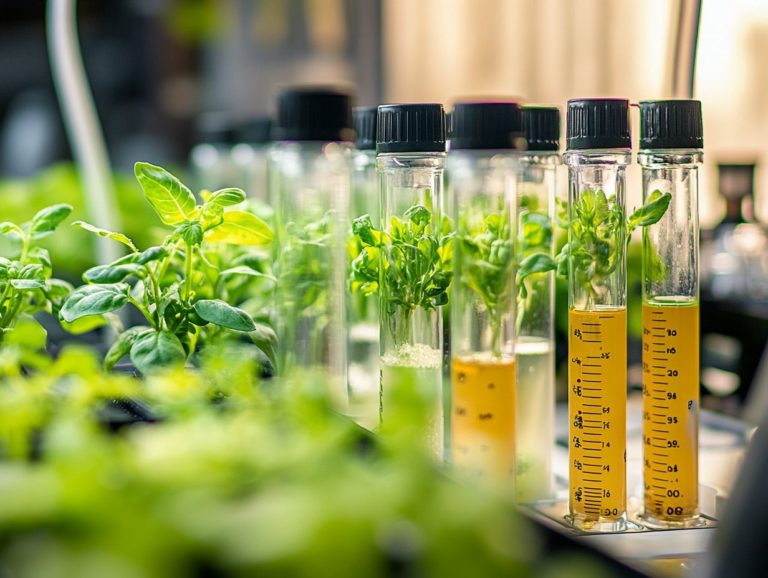How to Test Water Quality for Nutrient Absorption
Water quality is essential for optimal nutrient absorption, influencing everything from agricultural productivity to personal health. Understanding the impact of nutrient levels on aquatic ecosystems is crucial!
By grasping the various facets of water quality such as pH levels (the measure of acidity or alkalinity in water), mineral content, and potential contaminants you can make informed choices about your water sources! This guide will walk you through common water quality tests, how to interpret the results, and effective methods to enhance water quality.
Explore how these elements come together to foster a healthier environment for both plants and people, including strategies for nutrient cycling and addressing algal blooms.
Contents
- Key Takeaways:
- Understanding Water Quality and Nutrient Absorption
- Common Water Quality Tests
- Interpreting Water Quality Results
- Improving Water Quality for Better Nutrient Absorption
- Frequently Asked Questions
- What are the main nutrients that affect water quality in terms of nutrient absorption?
- What method can I use to test water quality for nutrient absorption?
- How does excessive nutrient absorption affect water quality?
- Is it necessary to test water quality for nutrient absorption in all bodies of water?
- How often should water quality testing for nutrient absorption be done? (including phosphorus and nitrogen tests)
- What actions can be taken if water quality testing shows high levels of nutrients?
Key Takeaways:

- Water quality directly affects nutrient uptake and absorption, making it essential to test and monitor regularly.
- pH, mineral and nutrient, and contaminant testing are common methods to assess water quality.
- Understanding and interpreting water quality results is crucial for determining the nutrient levels needed for optimal nutrient absorption and preventing nutrient overloading.
Understanding Water Quality and Nutrient Absorption
Grasping how water quality affects nutrient absorption is key for ensuring healthy aquatic ecosystems and maximizing crop productivity. Water quality significantly influences nutrient cycling processes, directly impacting the availability of essential nutrients that both aquatic plants and crops need for optimal growth.
Factors such as pH levels, electrical conductivity (how well water can conduct electricity, which relates to the amount of minerals present), and the presence of contaminants are crucial in determining how effectively nutrients are absorbed. To ensure optimal nutrient management, learn how to test your hydroponic nutrient solution. Managing nutrient levels is essential for preventing problems like algal blooms and hypoxia, which can result from nutrient overload in water bodies.
Why Water Quality Matters for Nutrient Absorption
Water quality is a critical factor influencing nutrient absorption because aquatic plants need specific nutrient levels to thrive.
Be aware that elements such as pH, dissolved oxygen, and the presence of contaminants play a vital role in how effectively these plants can absorb essential nutrients. If the water is too acidic or alkaline, it can impede the availability of key minerals like nitrogen and phosphorus, both of which are crucial for plant health.
Suboptimal levels of dissolved oxygen can stress aquatic life, impacting overall growth and increasing the risk of nutrient deficiencies. Neglecting water quality standards will limit nutrient uptake and may invite harmful conditions like algal blooms, disrupting the aquatic ecosystem and competing with plants for valuable resources.
Common Water Quality Tests
Common water quality tests are vital for accurately assessing the health of water bodies and grasping the nutrient levels present in aquatic environments. By conducting these tests, you gain valuable insights that can inform your decisions and actions regarding water management and conservation!
pH Testing

pH testing is an essential measure for evaluating water quality, as it has a direct impact on nutrient uptake and the overall health of aquatic ecosystems.
Maintaining the correct pH levels is vital since they dictate the availability of nutrients to aquatic plants. When the pH drifts too far from the optimal range, key nutrients like nitrogen, phosphorus, and potassium may become less accessible, resulting in deficiencies that hinder growth and vitality.
You might notice these deficiencies through various symptoms, such as yellowing leaves or stunted development, which ultimately disrupt the delicate balance of the ecosystem. Improper pH can also foster an environment ripe for harmful algae blooms, further complicating the well-being of aquatic life.
Mineral and Nutrient Testing
Mineral and nutrient testing is essential for identifying key nutrient components like nitrogen, phosphorus, and potassium that are vital for the growth of aquatic plants.
The process typically starts with collecting water samples from various locations to ensure a comprehensive analysis. Techniques such as light absorption measurement help ascertain the concentration of dissolved nutrients.
Field tests also allow for a rapid assessment of nutrient levels on-site. This provides immediate insights into the water’s quality and the available nutrient forms.
Understanding these components helps researchers and environmentalists. They can create strategies that promote healthy aquatic ecosystems.
Contaminant Testing
Contaminant testing is a crucial component of assessing water quality. It aims to identify harmful substances, including soluble salts and sodium chloride, which may impede nutrient absorption.
It’s essential to examine the levels of soluble salts and sodium chloride. These contaminants can disrupt the ecological balance of aquatic environments. Elevated sodium levels can increase salinity, negatively impacting the physiology of freshwater species.
Excessive soluble salts can limit the availability of essential nutrients. This hinders the growth and reproduction of fish and other aquatic organisms.
Regular testing for these contaminants, including nutrient testing and pH levels, enables water quality experts to make informed decisions that protect aquatic habitats. This ensures the sustainability of vital ecosystems.
Interpreting Water Quality Results
Interpreting water quality results is crucial for understanding nutrient levels’ implications on aquatic ecosystems and agricultural practices, especially in ensuring proper irrigation water conditions.
By analyzing these results, you gain valuable insights that inform sustainable management strategies. This ultimately enhances the health of water bodies and the productivity of your agricultural endeavors.
What Levels Indicate Good or Poor Quality

Determining levels that indicate good or poor water quality requires understanding the threshold values for various nutrient components and their effects on aquatic life.
When nitrogen and phosphorus concentrations rise, they can trigger the overgrowth of algae, resulting in algal blooms. These blooms can drastically reduce oxygen levels in the water, leading to hypoxia a condition where aquatic organisms struggle to survive due to inadequate oxygen supply.
On the flip side, water with low nutrient levels tends to be more balanced, fostering diverse species. Maintaining optimal nutrient levels is essential for ensuring a healthy aquatic ecosystem, minimizing contamination risks, and preserving biodiversity.
Improving Water Quality for Better Nutrient Absorption
Act now to improve water quality! This boost in nutrient absorption can significantly enhance agricultural productivity and strengthen ecosystems.
Improving water quality is essential for enhancing nutrient absorption in aquatic systems. This factor supports agricultural productivity through effective irrigation practices and promotes the overall health of ecosystems.
Methods for Purifying and Enhancing Water
Water purification methods include various filtration systems and chemical treatments. These techniques help improve nutrient absorption.
Advanced filtration systems, such as reverse osmosis and activated carbon filters, are crucial for removing impurities and enhancing overall water quality. It’s essential to wear safety gear, like gloves and goggles, to ensure safe handling of chemical reactants. Wearing safety gear not only keeps you safe but also boosts the effectiveness of your water treatment efforts!
The careful selection and application of these purification methods can significantly influence nutrient levels in the water. This creates a delicate balance that promotes ecosystem health and sustains aquatic life. Properly purified water supports better agricultural practices and contributes to enhancing public health and environmental conservation efforts.
Frequently Asked Questions
What are the main nutrients that affect water quality in terms of nutrient absorption?

The main nutrients that affect water quality for nutrient absorption are phosphorus, nitrogen, and carbon. These nutrients are essential for plant growth and significantly impact the health of aquatic ecosystems.
What method can I use to test water quality for nutrient absorption?
One common method to test water quality for nutrient absorption is measuring the concentration of nutrients present in the water. This can be done through chemical analysis or using test kits designed specifically for nutrient testing.
How does excessive nutrient absorption affect water quality?
Excessive nutrient absorption can lead to overgrowth of plant life, like algae, resulting in decreased oxygen levels and harming aquatic animals. This process is known as eutrophication and can significantly impact water quality.
Is it necessary to test water quality for nutrient absorption in all bodies of water?
Yes, testing water quality for nutrient absorption is essential in all bodies of water, including lakes, rivers, and oceans. Nutrient levels can vary greatly and significantly affect the ecosystem’s health, making regular testing crucial.
How often should water quality testing for nutrient absorption be done? (including phosphorus and nitrogen tests)
The frequency of water quality testing for nutrient absorption depends on factors such as the body of water and surrounding land use. Generally, it’s recommended to test at least once a year, but more frequent testing may be necessary in areas with high nutrient levels or agricultural activity.
What actions can be taken if water quality testing shows high levels of nutrients?
If water quality testing reveals high nutrient levels, steps can be taken to reduce nutrient input into the water. You can implement best management practices for farming or reduce fertilizer use in residential areas. You can also improve nutrient absorption by implementing wetland restoration projects.






